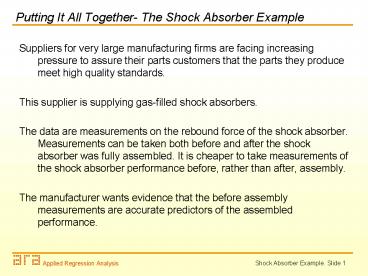Shock Absorber Example' Slide 1 PowerPoint PPT Presentation
1 / 10
Title: Shock Absorber Example' Slide 1
1
Putting It All Together- The Shock Absorber
Example
- Suppliers for very large manufacturing firms are
facing increasing pressure to assure their parts
customers that the parts they produce meet high
quality standards. - This supplier is supplying gas-filled shock
absorbers. - The data are measurements on the rebound force of
the shock absorber. Measurements can be taken
both before and after the shock absorber was
fully assembled. It is cheaper to take
measurements of the shock absorber performance
before, rather than after, assembly. - The manufacturer wants evidence that the before
assembly measurements are accurate predictors of
the assembled performance.
2
Basic Model
We must formulate a statistical model to predict
rebound force after assembly using the before
assembly measurement. This is a classic example
of a regression model!
3
Descriptive Statistics
MTB gt desc c1 c2 Descriptive Statistics
reboundb, rebounda Variable N N Mean SE
Mean StDev Minimum Q1 Median
Q3 reboundb 35 0 544.46 5.08 30.03
503.27 524.49 534.97 565.02 rebounda 35 0
535.17 4.99 29.49 494.00 511.00 524.00
555.00 Variable Maximum reboundb
615.70 rebounda 598.00
These are statistics formed from the marginal
distributions of rebounda, reboundb. These
distributions appear to be similar. Does this
mean there is a close relationship?
4
Marginal Distribution of Y
Doesnt look normal! Three clumps! Does this
mean we cant run a regression? NO!!!
5
Joint or Bivariate Distribution
Lets do a scatter plot. Which variable should be
on the Y axis?
Note three clusters of points. This implies room
for improvement in quality!
6
Regression Analysis
Regression Analysis rebounda versus reboundb
The regression equation is rebounda 18.2
0.949 reboundb Predictor Coef SE Coef
T P Constant 18.23 23.89 0.76
0.451 reboundb 0.94946 0.04380 21.67
0.000 S 7.66973 R-Sq 93.4 R-Sq(adj)
93.2 Analysis of Variance Source DF
SS MS F P Regression 1
27636 27636 469.80 0.000 Residual Error 33
1941 59 Total 34 29577
Conditional Std Dev 7.67. Marginal Std Dev
29.45
7
T-tests
Suppose before measurements were perfect
predictors. What would this mean? One School of
Thought All you need is very accurate
predictions Another School of Thought (no
adjustment)
8
T-tests continued
Lets test a slight modification Since N is
relatively small, lets test at the 10 percent
significance level.
Step 1 Compute t critical value MTB gt InvCDF
.05 SUBCgt T 33. P( X lt x ) x
0.05 -1.69236
Step 3 Compute p-value MTB gt CDF -1.1539 SUBCgt
T 33. x P( X lt x ) -1.1539
0.128415
Step 2 Compute t statistic MTB gt let
k1(.94946-1)/.0438 MTB gt print k1 K1
-1.15388
MTB gt let k1.12842 MTB gt print k1 K1
0.256800
9
Residual Diagnostics
Residuals vs. Fitted looks pretty good
Residuals are much more normal than marginal dist
of Y
10
Prediction
Lets predict Rebounda given Reboundb550.
MTB gt regress c2 1 c1 SUBCgt predict 550. The
regression equation is rebounda 18.2 0.949
reboundb gtgtgt here I deleted redundant output
ltltlt Fit SE Fit 95 C.I.
95 P.I. 540.43 1.32 ( 537.75,
543.11) ( 524.59, 556.27)
The value of FIT is computed as
540.4318.2.9494550 SE Fit is the part of
prediction error due to sampling error in
regression coefficients. s is the part due to
inherent variability. 95 Confidence Interval
(C.I.) (540.43 - 21.32,540.43 21.32) 95
Prediction Interval (P.I.) (540.43 /-
2sqrt(7.6721.322))

